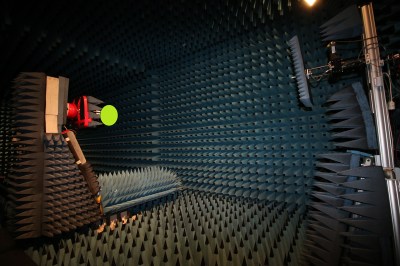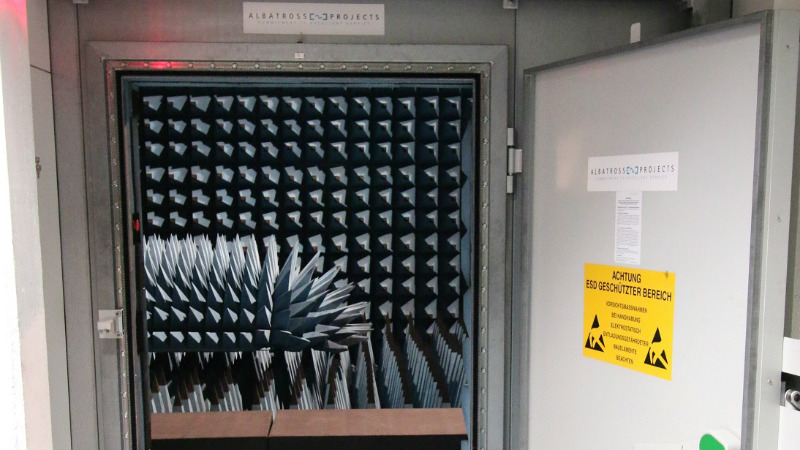[Mathieu Stephan] has something new in the works, and while he isn’t ready to take the wraps off of it yet, he was kind enough to document his experience putting the mysterious new gadget through its paces inside an anechoic chamber. Considering the majority of us will never get inside of one of these rooms, much less have the opportunity to test our own hardware in one, he figured it was the least he could do.
 If you’re not familiar with an anechoic chamber, don’t feel bad. It’s not exactly the sort of thing you’ll have at the local makerspace. Put simply it’s a room designed to not only to remove echos on the inside, but also be completely isolated from the outside. But we aren’t just talking about sound deadening, the principle can also be adapted to work for electromagnetic waves. So not only is in the inside of the anechoic chamber audibly silent, it can also be radio silent.
If you’re not familiar with an anechoic chamber, don’t feel bad. It’s not exactly the sort of thing you’ll have at the local makerspace. Put simply it’s a room designed to not only to remove echos on the inside, but also be completely isolated from the outside. But we aren’t just talking about sound deadening, the principle can also be adapted to work for electromagnetic waves. So not only is in the inside of the anechoic chamber audibly silent, it can also be radio silent.
This is important if you want to test the performance of things like antennas, as it allows you to remove outside interference. As [Mathieu] explains, both the receiver and transmitter can be placed in the chamber and connected to a vector network analyzer (VNA). The device is able to quantify how much energy is being transferred between the two devices, but the results will only be accurate if that’s the only thing the VNA sees on its input port.
[Mathieu] can’t reveal images of the hardware or the results of the analysis because that would give too much away at this point, but he does provide the cleverly edited video after the break as well as some generic information on antenna analysis and the type of results one receives from this sort of testing. Our very own [Jenny List] has a bit more information on the subject if you’d like to continue to live vicariously through the accounts of others. For the rest of us, we’ll just have to settle for some chicken wire and a wooden crate.















Fwiw. Here is a chamber in Perth, Western Australia built circa 2000, I arranged 50% state government funding (WAISS program) for it late 1999 run by a fellow graduate Roman, one or two years ahead of me circa 1977 Western Australian Institute of Technology. Very clever chap who’s achieved mil emc/EMP test status and other even more onerous ones with I understand UK oversight association too.
http://qdl.com.au
Aren’t you prolific? Well done! Always nice to hear a little of the story behind the scenes.
These pointy bits on the floor look nasty. You probably need good shoes to go inside… Oh i see, there is wood boards on the floor in the first picture.
I assume that those pointy bits are made of foam. This is not a deathtrap from Prince Of Persia ;)
Stinky hard foam, yes
really, why does that foam smell so damn bad
It’s surely from all those pungent radio waves trapped inside
Yes, foam. You would damage it by walking on it. The material crumbles easily.
There are special pieces with reduced performance parameters that are used as walkway. I don’t see any in this chamber.
Correction, one picture shows it clearly, albeit misaligned.
I had the good fortune to visit an (acoustic) anechoic chamber at the Physics Department in the University of Newcastle in autumn 1987. It is a very strange experience – you feel as if you are nowhere, as there is no reverberation at all, just as if your head were wrapped in blankets, yet your eyes tell you there is a space around you. As for the floor, I can’t speak for the illustration, but there they had a metal grille suspended above the inward-pointing pyramids by posts, and visitors walked on that.
If you would like more information concerning anechoic Chambers, far field, and near field testing, you should check out NSI-MI technologies and PPG Cuming Microwave. The former creates test software and hardware, while the latter manufacturers the anechoic material. Both companies also design and build anechoic chambers.
Back in the day… I recall more than one audio recording booth and I want to say behind a drum set… lined with “egg cartons” made of foam… however I am not finding a reference online at the moment other than I am guessing with cellulosic material: http://www.acousticsfirst.com/eggc.htm
I’m guessing foam padding from mattresses could be used also. Would be interesting what the acoustic profile is of the different foam padding materials (i.e. space foam, gel foam, etc.) and potential modifications to enhance performance on a budget (spray coating to change properties… even electromagnetic properties). I know double layers of drywall are used for housing to dampen sound and there are acoustic panels and materials on the market that might be an improvised method materials source.
A Bat could not fly 1 inch in chambers like these.
It’d be fine so long as you left the lights on.
I mean they can fly far up where there’s nothing close enough to reflect their vocalizations before they decay, so I’d hazard to guess they’d fly in the chamber but would probably run smack into a foam pyramid and become very confused.
Semi-related, but you know those really fluffy moths you see from time to time? Their fuzziness is an adaptation to reduce sonic reflections and make them harder for bats to find. Thought that was pretty neat. Natural stealth versus natural sonar.
“So not only is in the inside of the anechoic chamber audibly silent, it can also be radio silent.”
1) You’re mixing things here. An anechoic chamber just means “no echoes” – it means there aren’t reflections off the walls. This doesn’t mean it’s radio silent. The foam doesn’t make it radio silent, for instance – it’s the Faraday cage the room is built into. You can have a shielded room (radio quiet) without absorbers, it’s just crap for antenna testing. Likewise, you can have an anechoic chamber used for antenna testing that isn’t radio quiet, either.
2) It doesn’t *have* to be audibly silent. It’s just that for “normal cost” anechoic chambers (the ~$100K kind, ha) they’ll use pyramidal foam absorbers, because they’re “low cost”, and those happen to be decent sound absorbers as well. But if you’ve got money to burn and want crazy performance in very little space, you can also build an anechoic chamber with ferrite tiles – and those *aren’t* sound absorbing (there are also crazy-expensive ceramic pyramidal absorbers which also aren’t absorbing).
My favorite anechoic chamber story is that obviously, since the dimensions of each chamber are usually a little different, the standard size pyramidal absorbers won’t all line up perfectly to fit in the room. So you basically have to arts-and-crafts your way to make them fit. And what carefully designed, precision engineered tool do they recommend for doing this? An electric carving knife. Yeah, that was a fun thing to justify to purchasing.
Oh yeah, an electric turkey knife is wonderful for working with foam. It ain’t radio science, but I use one to sculpt waterproof kayak foam into a good shape to upholster into motorcycle seats. Works great.
If you want to do the same with styrofoam, a nichrome wire hooked up to a battery goes through it as if it weren’t even there. Fun to pretend you’re using some kind of cyberpunk monofilament knife or whatever.
In the rf arena, there is the rarer room where all the internal surfaces are covered in ferrites to reflect most rf back.
I got to go in the anechoic chamber at Matra Marconi once, which they used for testing the radios (etc) on satellites. The room was huge, about the size of a church indies, but you couldn’t hear someone talking from more than about 3-4m away. A really strange experience.
That stuff is so expensive! Maybe it’s time to build a hang-printer that squirts foam….
A local business here has one that I had the luck/chore to visit. It is an interesting experience to stand in such a silent room. Interesting fact, the pyramids are hard, not soft foam like you would expect.
Interesting history reference of a huge and oldest types of Anechoic Chamber from Bell Labs: https://www.bell-labs.com/anechoic-chamber/